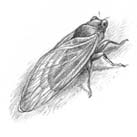JOHN JAMES AUDUBON (1785–1851) was a master at creating powerful images filled with beauty and emotion, even though his subjects were merely birds. He spent most of his life traveling over much of eastern North America, often on foot, carrying paints and paper, sketching constantly, documenting the native plants and animals as they existed in the early 1800s.
Before Audubon came along, wildlife artists painted their subjects in static and stiff poses, as though mounted in a display case. But Audubon filled each of his paintings with a zest and vigor that makes them seem to fly across the page. This was years before photography, so his paintings are a record of animals and plants of another century. And his artistic ability was self-taught, which makes his work even more amazing.
The landscape that inspired him looked much different than it does today. Roads were scarce; this was long before the age of the automobile. Completion of the transcontinental railroad was still decades away. The population of the United States was only around ten million; that’s only about four people per square mile if you sprinkled them evenly over the country.

Today, the population is more than thirty times that, a density of nearly eighty people per square mile.
Audubon walked or rode horseback through vast tracts of forest that stretched from the Atlantic Ocean to the Mississippi River, through deep woods of ancient, towering trees hundreds of years old. Thousands of miles of pristine rivers and millions of acres of woodland habitat had not yet been replaced or polluted by farms and industry. That would come later.
Along those rivers roamed animals we wouldn’t expect to see there today: cougars and jaguars, wolves and bison, lynx and elk. Audubon encountered birds that are now extinct, such as the ivory-billed woodpecker, the Carolina parakeet, and the passenger pigeon mentioned in this story.
For nearly two years he traveled with an assistant, Joseph Mason. Joseph was a great help to Audubon; and although only a teenager (he was thirteen when he started out with Audubon), he became very skilled at painting botanical subjects, particularly wildflowers. Many of the beautiful backgrounds of plants and flowers in the bird portraits are credited to Joseph.
Audubon’s life as a painter and naturalist was often difficult: He was separated from his family for long periods of time while out gathering specimens for his paintings, frequently living hand-to-mouth. No one was paying him to paint birds; it was his idea and his passion. But he managed to paint more than four hundred North American bird species, each one a carefully rendered portrait—from the dowdy field sparrow to the flamboyant flamingo.
It’s a bit ironic that his paintings depict such lively, animated birds. His artistic methodology would be illegal today! He killed nearly all of his subjects, using a shotgun, and did indeed use wire to position the dead specimens into lifelike poses. His images were huge, all of them life-size; the pages of his Birds of America were nearly three feet tall, so large that two people were needed to turn the pages carefully, and special tables were required to display the books.
In 1821 Audubon lived for about four months at Oakley Plantation, not far from New Orleans, Louisiana. To earn his room and board while staying at Oakley he gave the plantation owner’s daughter, Eliza Pirrie, dancing and drawing lessons. By reading his journals, we know that Audubon was particularly charmed and inspired by the woods and bayous around Oakley and worked diligently on many of his paintings at the plantation.
The fictionalized events in the story of Celeste take place during those four months. Some of it is true: Joseph was indeed shot while out flushing turkeys during a hunt, for example; and Audubon did keep a live ivory-billed woodpecker and a live osprey for a time.
But did Joseph have a field mouse for a companion? Was Eliza’s old dollhouse tucked away in the attic? I like to think so.

I am so fortunate to have honest, encouraging, thoughtful, and talented friends who have spent many hours of their time reading drafts of this story and kindly giving me helpful suggestions. Many, many thanks to Quinn Keeler, Laura Behm, Nancy Powell, Roland Smith, Margaret Elliot, and Nan Fry.
Thank you, Amy Ryan, for your marvelous enthusiasm and energy with the design and layout.
And to my wonderful editor and friend, Katherine Tegen, with much love and appreciation, I dedicate this book.